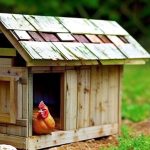Transporting chickens requires careful consideration of their specific needs to ensure their well-being and safety. Chickens are sensitive animals prone to stress during transport, which can negatively impact their health and quality of life. Key factors to consider include temperature regulation, ventilation, and stress minimization.
Chickens need a comfortable and secure environment during transport. This includes adequate space for movement, protection from extreme temperatures and harsh weather, and provisions for food and water on longer journeys. The duration of the trip should be factored into planning.
Selecting appropriate transport containers, bedding, insulation, and ventilation systems is crucial for meeting chickens’ needs during transit. These choices directly affect the animals’ comfort and stress levels, which in turn influence their overall health and the quality of poultry products they will produce. Understanding and addressing the specific requirements of chickens during transport is essential for maintaining their welfare and ensuring the quality of poultry production.
Proper care during transportation contributes to the overall health and productivity of the chickens upon arrival at their destination.
Table of Contents
- 1 Choosing the Right Transport Container for Chickens
- 2 Providing Adequate Bedding and Insulation
- 3 Ensuring Proper Ventilation and Airflow
- 4 Monitoring and Regulating Temperature
- 5 Minimizing Stress and Disturbances During Transport
- 6 Ensuring a Smooth and Safe Journey for Chickens
- 7 FAQs
- 7.1 What are the best ways to keep chickens warm during transport?
- 7.2 How can insulated crates or boxes help keep chickens warm during transport?
- 7.3 What type of bedding is best for keeping chickens warm during transport?
- 7.4 How can heat packs or warm water bottles be used to keep chickens warm during transport?
- 7.5 Are there any other tips for keeping chickens warm during transport?
Key Takeaways
- Chickens need to be transported in a way that meets their specific needs, including temperature regulation and minimizing stress.
- Choosing the right transport container is crucial for the safety and well-being of the chickens during transport.
- Adequate bedding and insulation are essential to ensure the comfort and health of the chickens during transportation.
- Proper ventilation and airflow are necessary to maintain a healthy environment for the chickens during transport.
- Monitoring and regulating temperature is important to prevent heat stress or hypothermia in chickens during transport.
Choosing the Right Transport Container for Chickens
Key Considerations for Choosing a Transport Container
When choosing a transport container for chickens, it’s essential to consider factors such as size, material, and design. The container should be spacious enough to allow the chickens to move around freely and comfortably, with enough room for them to stretch their wings. Additionally, it should be made of durable and sturdy material that can withstand the rigors of transportation, while also providing adequate protection from extreme temperatures and harsh weather conditions.
Design and Ventilation Requirements
The design of the container should also allow for proper ventilation and airflow, as well as easy access for feeding and watering the chickens during the journey. This is crucial for maintaining a comfortable and healthy environment for the chickens during transport.
The Importance of Proper Transport Containers for Chicken Welfare
By considering factors such as size, material, design, and ventilation, it becomes possible to create a comfortable and secure environment for the chickens, minimizing stress and ensuring their well-being throughout the journey. This careful consideration is essential for providing the best possible conditions for the chickens during transport, ultimately leading to better quality poultry products and overall animal welfare.
Providing Adequate Bedding and Insulation

Providing adequate bedding and insulation is essential for creating a comfortable and secure environment for chickens during transport. Bedding helps to absorb moisture and provide a soft surface for the chickens to rest on, while insulation helps to regulate temperature and protect the chickens from extreme heat or cold. By providing the right bedding and insulation, it becomes possible to minimize stress and ensure the well-being of the chickens throughout the journey.
When it comes to bedding for chickens during transport, it’s important to choose materials that are absorbent, comfortable, and easy to clean. Straw, wood shavings, or shredded paper are commonly used as bedding materials, providing a soft surface for the chickens to rest on while also absorbing moisture. Additionally, insulation materials such as foam or thermal blankets can be used to regulate temperature and protect the chickens from extreme heat or cold.
By providing adequate bedding and insulation, it becomes possible to create a comfortable and secure environment for the chickens during transport, minimizing stress and ensuring their well-being throughout the journey. Providing adequate bedding and insulation is crucial for creating a comfortable and secure environment for chickens during transport. By choosing the right materials and ensuring proper installation, it becomes possible to minimize stress and ensure the well-being of the chickens throughout the journey.
This careful consideration is essential for providing the best possible conditions for the chickens during transport, ultimately leading to better quality poultry products and overall animal welfare.
Ensuring Proper Ventilation and Airflow
Proper ventilation and airflow are essential for creating a comfortable and secure environment for chickens during transport. Good ventilation helps to remove excess moisture, odors, and airborne pathogens from the transport container, while also providing fresh air for the chickens to breathe. By ensuring proper ventilation and airflow, it becomes possible to minimize stress and ensure the well-being of the chickens throughout the journey.
When it comes to ventilation for chickens during transport, it’s important to provide openings or vents that allow for fresh air to enter the container while also allowing stale air to exit. This helps to maintain a healthy air quality inside the container, reducing the risk of respiratory issues or heat stress for the chickens. Additionally, it’s important to consider factors such as temperature regulation and protection from drafts when planning ventilation for the transport container.
By ensuring proper ventilation and airflow, it becomes possible to create a comfortable and secure environment for the chickens during transport, minimizing stress and ensuring their well-being throughout the journey. Proper ventilation and airflow are crucial for creating a comfortable and secure environment for chickens during transport. By providing openings or vents that allow for fresh air to enter the container while also allowing stale air to exit, it becomes possible to maintain a healthy air quality inside the container, reducing the risk of respiratory issues or heat stress for the chickens.
This careful consideration is essential for providing the best possible conditions for the chickens during transport, ultimately leading to better quality poultry products and overall animal welfare.
Monitoring and Regulating Temperature
Monitoring and regulating temperature is essential for ensuring the well-being of chickens during transport. Chickens are sensitive to extreme temperatures and can easily become stressed or suffer from heat or cold stress if proper temperature regulation is not maintained. By monitoring and regulating temperature throughout the journey, it becomes possible to create a comfortable and secure environment for the chickens, minimizing stress and ensuring their well-being.
When transporting chickens, it’s important to monitor temperature levels inside the transport container and take steps to regulate them as needed. This may involve using insulation materials such as foam or thermal blankets to protect against extreme heat or cold, as well as providing adequate ventilation to maintain a comfortable temperature inside the container. Additionally, it’s important to consider factors such as weather conditions and duration of the journey when planning temperature regulation for transporting chickens.
By monitoring and regulating temperature throughout the journey, it becomes possible to create a comfortable and secure environment for the chickens, minimizing stress and ensuring their well-being. Monitoring and regulating temperature is crucial for ensuring the well-being of chickens during transport. By using insulation materials, providing adequate ventilation, and considering factors such as weather conditions and duration of the journey, it becomes possible to maintain a comfortable temperature inside the transport container, minimizing stress and ensuring the well-being of the chickens throughout the journey.
This careful consideration is essential for providing the best possible conditions for transporting chickens, ultimately leading to better quality poultry products and overall animal welfare.
Minimizing Stress and Disturbances During Transport

Handling Chickens with Care
When transporting chickens, it’s important to minimize stress by handling them gently and avoiding sudden movements or loud noises that can startle them. This gentle handling helps to reduce anxiety and creates a sense of security for the chickens.
Creating a Calm Environment
Additionally, it’s important to provide a calm and quiet environment inside the transport container, with minimal disturbances that could cause stress or anxiety for the chickens. A peaceful environment helps to reduce stress and promotes a sense of well-being for the chickens during transport.
The Importance of Minimizing Stress
Minimizing stress and disturbances is crucial for ensuring the well-being of chickens during transport. By handling them gently, avoiding sudden movements or loud noises, and providing a calm environment inside the transport container, it becomes possible to minimize stress and ensure their well-being throughout the journey. This careful consideration is essential for providing the best possible conditions for transporting chickens, ultimately leading to better quality poultry products and overall animal welfare.
Ensuring a Smooth and Safe Journey for Chickens
Ensuring a smooth and safe journey is essential for maintaining the well-being of chickens during transport. It’s important to plan ahead and take steps to minimize potential risks or hazards that could affect the safety of the chickens throughout the journey. By ensuring a smooth and safe journey, it becomes possible to create a comfortable and secure environment for the chickens, minimizing stress and ensuring their well-being.
When transporting chickens, it’s important to plan ahead by considering factors such as weather conditions, road conditions, duration of the journey, and potential risks or hazards that could affect their safety. This may involve taking steps such as securing the transport container properly, avoiding sudden stops or sharp turns that could cause injury to the chickens, as well as providing adequate food and water throughout the journey. By ensuring a smooth and safe journey, it becomes possible to create a comfortable and secure environment for the chickens, minimizing stress and ensuring their well-being.
Ensuring a smooth and safe journey is crucial for maintaining the well-being of chickens during transport. By planning ahead, securing the transport container properly, avoiding potential risks or hazards, as well as providing adequate food and water throughout the journey, it becomes possible to create a comfortable and secure environment for the chickens while minimizing stress and ensuring their well-being. This careful consideration is essential for providing the best possible conditions for transporting chickens, ultimately leading to better quality poultry products and overall animal welfare.
If you’re looking for more information on keeping chickens warm, you might also be interested in learning about how to insulate a chicken coop. This article from Poultry Wizard provides helpful tips on how to keep your chickens cozy and comfortable during the colder months. Check it out here.
FAQs
What are the best ways to keep chickens warm during transport?
Some of the best ways to keep chickens warm during transport include using insulated crates or boxes, providing bedding such as straw or shavings, and using heat packs or warm water bottles.
How can insulated crates or boxes help keep chickens warm during transport?
Insulated crates or boxes can help keep chickens warm during transport by providing a barrier against cold temperatures and wind. They can help retain the chickens’ body heat and provide a more comfortable environment during the journey.
What type of bedding is best for keeping chickens warm during transport?
Bedding such as straw or shavings can help keep chickens warm during transport by providing insulation and a comfortable surface for them to rest on. It can also help absorb moisture and provide some additional warmth.
How can heat packs or warm water bottles be used to keep chickens warm during transport?
Heat packs or warm water bottles can be placed in the transport crate or box to provide additional warmth for the chickens. They can help maintain a comfortable temperature and prevent the chickens from getting too cold during the journey.
Are there any other tips for keeping chickens warm during transport?
Other tips for keeping chickens warm during transport include avoiding transporting them during extremely cold weather, providing adequate ventilation in the transport crate or box, and minimizing stress during the journey to help the chickens maintain their body temperature.
Meet Walter, the feathered-friend fanatic of Florida! Nestled in the sunshine state, Walter struts through life with his feathered companions, clucking his way to happiness. With a coop that’s fancier than a five-star hotel, he’s the Don Juan of the chicken world. When he’s not teaching his hens to do the cha-cha, you’ll find him in a heated debate with his prized rooster, Sir Clucks-a-Lot. Walter’s poultry passion is no yolk; he’s the sunny-side-up guy you never knew you needed in your flock of friends!







